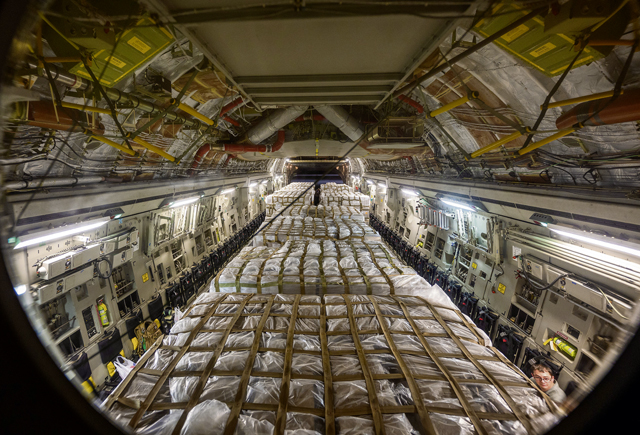
“Together, we deliver” is U.S. Transportation Command’s motto, and it played out in real time in May 22. The first airplane importing 132 pallets, or 78,000 pounds, of specialty infant formula arrived at Indianapolis International Airport. The C-17 Globemaster III military transport aircraft was loaded the day before at Ramstein Air Base, kicking off Operation Fly Formula.
“Whether the needs are in Ukraine, India, or even right here at home; from deploying combat-credible forces, to providing vaccines, food, water and supplies during a pandemic or natural disaster, USTRANSCOM will deliver,” said Gen. Jacqueline D. Van Ovost, commander, USTRANSCOM. “Together with our industry partners, and allies and partners, we not only project and sustain the joint force to help ensure national security, but we continue to deliver hope, whenever and wherever.”
Typically, the process to transport this product from Europe to the U.S. would take two weeks. President Joe Biden announced Operation Fly Formula May 18, when he requested the Departments of Agriculture and Health and Human Services to “work expeditiously to identify any and all avenues to speed importation…” Biden further requested that over the next week to work with the Department of Defense to use contracted airlift to import the needed formula. In military jargon, that was an implied task and a warning order to USTRANSCOM, and planning started immediately.
Hours before the president’s announcement, U.S. Navy Vice Adm. Dee Mewbourne, USTRANSCOM deputy commander, learned of the impending mission.
“There is an emerging requirement to move baby formula into CONUS (continental U.S.) and it is anticipated that an EXECSEC memo (a document directing and authorizing the task) will be signed tonight or tomorrow to have formula moved via DoD-procured airlift,” he shared via correspondence to staff. “These moves will look similar to the moves we did for COVID vaccine needles/syringes.”
The logistics planners in USTRANSCOM’s J3, the directorate responsible for operations planning and execution, and in AQ, the acquisition directorate, knew a requirement was imminent but didn’t know any of the requirements for planning. How much? Where was it coming from? When does it need to be delivered and to where? How do we engage with commercial carriers and ask for their availability for services if we can’t articulate what we need them to do?
Some pieces of the puzzle were learned the next day, May 19, when Thomas J. Vilsack, the Secretary of Agriculture, sent a Request for Assistance to the Secretary of Defense Lloyd J. Austin III, that requested “DOD provide support by establishing a dedicated, contracted air-bridge to move infant formula from Zurich, Switzerland, to Plainfield, Indiana, in the U.S. The company manufacturing this formula reports it takes approximately 21 days through commercial aircraft for the formula to ship and clear customs so it can enter distribution.”
U.S. Navy Cmdr. Michael Sargent, a planner in USTRANSCOM’s J3 Sustainment Division, was tagged to oversee the planning efforts. With a draft Action Memo in hand, he assembled the necessary players from across the USTRANSCOM Joint Deployment and Distribution Enterprise and multiple federal agencies, from DoD, to State, to Agriculture, and Health and Human Services to places like Scott Air Force Base, Illinois, to multiple agency headquarters in Washington D.C. and Airmen in Europe.
One of USTRANSCOM capabilities is giving leaders the options to meet strategic mobility challenges.
With the team assembled, virtual planning meetings began in earnest. Every roadblock was mitigated and alternate solutions were discussed until resolution. The pieces of the puzzle came together and approvals were in hand, but the sense of urgency led to another course of action because the long pole in the tent was the time to contract the flights.
Robert Brisson, USTRANSCOM J3 deputy director, stated during one of the virtual meetings, “We’ve got two C-17s on Bravo Alert at Ramstein. If we can get the cargo from Switzerland to Ramstein, we can have wheels up Saturday (May 21) night.”
Due to the urgency of the situation, Austin approved U.S. military aircraft for this mission, shortening the timeline by a couple days that would have been required for contract acquisition, showcasing once again USTRANSCOM’s motto, “Together, we deliver.”
USTRANSCOM exists as a warfighting combatant command to project and sustain military power at a time and place of the nation’s choosing. Powered by dedicated men and women, TRANSCOM underwrites the lethality of the joint force, advances American interests around the globe, and provides our nation’s leaders with strategic flexibility to select from multiple options, while creating multiple dilemmas for our adversaries.


